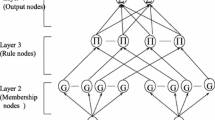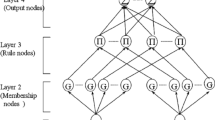Abstract
Natural language commands are generated by intelligent human beings. As a result, they contain a lot of information. Therefore, if it is possible to learn from such commands and reuse that knowledge, it will be a very efficient process. In this paper, learning from such information rich voice commands for controlling a robot is studied. First, new concepts of fuzzy coach-player system and sub-coach are proposed for controlling robots with natural language commands. Then, the characteristics of the subjective human decision making process are discussed and a Probabilistic Neural Network (PNN) based learning method is proposed to learn from such commands and to reuse the acquired knowledge. Finally, the proposed concept is demonstrated and confirmed with experiments conducted using a PA-10 redundant manipulator.

















Similar content being viewed by others
Explore related subjects
Discover the latest articles, news and stories from top researchers in related subjects.References
Menzel P, D’Aluisio F (2000) Robosapiens. The MIT Press, UK, London
Pineau J, Montemerlo M, Pollack M, Roy N, Thrun S (2003) Towards robotic assistants in nursing homes: challenges and results. Rob Auton Syst 42(3–4):271–281
Fong T, Nourbakhsh I, Dautenhahn K (2003) A survey of socially interactive robots. Rob Auton Syst 42:143–166
Oates T, Schmill MD, Cohen PR (2000) A method for clustering the experience of a mobile robot that accord with human judgement. In: Proceedings of the seventh national conference on artificial intelligence:846–851
Roy D (2003) Grounded spoken language acquisition: experiments in word learning. IEEE Trans on Multimedia 5(2):197–209
Roy D, Hsio K, Mavridis N (2004) Mental imagery for a conversational robot. IEEE Trans Syst Man Cybern B Cybern 34(3):1374–1383
Ballard DH, Chen Y (2003) A multimodal learning interface for word acquisition. Proc IEEE Int Conf Acoust Speech Signal Processing 5:784–787
Chen Y, Ballard DH (2004) A multimodal learning interface for grounding spoken language in sensory perceptions. ACM Trans Appl Perceptions 1(1):57–80
Lin CT, Kan MC (1998) Adaptive fuzzy command acquisition with reinforcement learning. IEEE Trans Fuzzy Syst 6(1):102–121
Pulasinghe K, Watanabe K, Izumi K, Kiguchi K (2004) A modular fuzzy-neuro controller driven by spoken language commands. IEEE Trans Syst Man Cybern B Cybern 34(1):293–302
Chatterjee A, Pulasinghe K, Watanabe K, Izumi K (2005) A particle-swarm-optimized fuzzy-neural network for voice-controlled robot systems. IEEE Trans Ind Electron 52(6):1478–1489
Pulasinghe K, Watanabe K, Izumi K, Kiguchi K (2003) Control of redundant manipulators by fuzzy linguistic commands. In: Proceedings of the SICE annual conference, Fukui, Japan:2819–2824
Jayawardena C, Watanabe K, Izumi K (2004) Knowledge acquisition by a sub-coach in a coach-player system for controlling a robot. In: Proceedings of the 4th international conference on advanced mechatronics, Hokkaido, Japan:601–606
Jayawardena C, Watanabe K, Izumi K (2004) Probabilistic neural network based learning from fuzzy voice commands for controlling a robot. In: Proceedings of the international conference on control, automation, and systems, Bangkok, Thailand:2011–2016
Jayawardena C, Watanabe K, Izumi K (2004) Intelligent sub-coach construction in a fuzzy coach-player system for controlling a robot manipulator. In: Proceedings of the joint 2nd international conference on soft computing and intelligent systems and 5th international symposium on advanced intelligent systems (SCIS & ISIS 2004), Yokohama, Japan:CD-ROM
Råde L, Westergren B (1999) Mathematics Handbook for Science and Engineering. 4th edn. Springer, Berlin Heidelberg New York
Lee CC (1990) Fuzzy logic in control systems: fuzzy logic controller, Part I. IEEE Trans on Systems, Man and Cybernetics 20(2):404–418
Lee CC (1990) Fuzzy logic in control systems: fuzzy logic controller, Part II. IEEE Trans on Systems, Man and Cybernetics 20(2):419–435
Mitubishi Heavy Industries Ltd., PA-10 portable general purpose intelligent arm programming manual - rev.1
Specht DF (1990) Probabilistic neural networks. Neural Networks 3(1):109–118
Raghu PP, Yegnanarayana B (1998) Supervised texture classification using a probabilistic neural network and constraint satisfaction model. IEEE Trans on Neural Networks 9(3):516–522
Ganchev T, Fakotakis N, Kokkinakis G (2003) Impostor modeling techniques for speaker verification based on probabilistic neural networks. In: Proceedings of IASTED international conference on signal processing, pattern recognition, and applications, Rhodes, Greece:185–190
Ganchev T, Fakotakis N, Kokkinakis G (2003) Locally recurrent probabilistic neural networks for text independent speaker verification. Proc of the EuroSpeech 3:1673–1676
Romero RD, Touretzky DS, Thibadeau RH (1997) Optical chinese character recognition using probabilistic neural networks. Pattern Recognition 30(8):1279–1292
Musavi MT, Chan KH, Hummels DM, Kalantri K (1994) On the generalization ability of neural-network classifier. IEEE Trans on Pattern Analysis and Machine Intelligence 16(6):659–663
Duda RO, Hart PE, Stork DG (2004) Pattern classification. 2nd edn. Wiley, New York
Mao KZ, Tan KC, Ser W (2000) Probabilistic neural-network structure determination for pattern classification. IEEE Trans on Neural Networks 11(4):1009–1016
Burrascano P (1991) Learning vector quantization for the probabilistic neural network. IEEE Trans on Neural Networks 2(4):458–461
Author information
Authors and Affiliations
Corresponding author
Rights and permissions
About this article
Cite this article
Jayawardena, C., Watanabe, K. & Izumi, K. Controlling a robot manipulator with fuzzy voice commands using a probabilistic neural network. Neural Comput & Applic 16, 155–166 (2007). https://doi.org/10.1007/s00521-006-0056-8
Received:
Accepted:
Published:
Issue Date:
DOI: https://doi.org/10.1007/s00521-006-0056-8




